Table of Contents
Morning glories are nature’s way of welcoming the day, with blossoms that unfurl at sunrise and create a kaleidoscope of color in any garden. These enchanting climbers possess a timeless charm, gracing trellises, fences, and walls with their cascading beauty. The morning glory plant, scientifically known as Ipomoea, is a fast-growing, flowering vine that thrives in sunny conditions. Renowned for its striking blossoms that unfurl with the morning sun, these plants bring a burst of color to gardens, patios, and balconies.
When grown on a trellis, these stunning plants create a striking vertical display, adding beauty and charm to any garden. Cultivating morning glories on trellis structures not only enhances their natural climbing tendencies but also makes it easier to care for these hardy vines. Whether you’re an experienced gardener or just starting your green journey, Morning Glories offer a blend of elegance and simplicity that few plants can match. With their resilience and ability to transform vertical spaces into vibrant displays, they bring life and personality to your outdoor haven. Let’s embark on a journey to explore the art and science of growing and caring for these captivating vines.
How to Grow Morning Glories
Selecting the Right Spot
Morning glories are sun-loving plants that flourish in areas with ample sunlight. Choose a location that receives 6 to 8 hours of direct sunlight each day. They grow best in well-draining soil that retains some moisture without becoming waterlogged. When selecting a spot, also ensure there is sufficient vertical space for the vines to climb and spread.
How to Prepare the Soil?
Although morning glories can adapt to various soil conditions, preparing the soil improves their growth and bloom potential. Follow these steps:
- Loosen the Soil: Use a garden fork or tiller to loosen the soil to a depth of 12 to 18 inches. This allows roots to establish more easily.
- Enrich with Organic Matter: Incorporate compost, aged manure, or leaf mold into the soil to boost nutrients and improve drainage.
- Test the pH: Morning glories prefer slightly acidic to neutral soil with a pH range of 6.0 to 7.5. If necessary, amend the soil to achieve this balance.
How to Plant Morning Glory Seeds?
Proper seed preparation is key to ensuring successful germination. Here’s a detailed guide:
- Scarify the Seeds: The tough outer coating of morning glory seeds can inhibit germination. Use a nail file or sandpaper to gently nick the seed coat.
- Soak the Seeds: Place the scarified seeds in warm water for 12 to 24 hours. This softens the seed coat, making it easier for the seeds to sprout.
- Planting Time: Sow seeds directly into the soil after the last frost date in your area (March 21st – 2nd week in April usually). Morning glories are sensitive to cold and should not be planted until the soil temperature reaches at least 60°F.
- Spacing and Depth: Plant seeds 1/2 inch deep and space them 6 to 12 inches apart. Cover lightly with soil and water thoroughly.
Supporting Growth with a Trellis
Morning glories are natural climbers and perform best when given a sturdy support structure. Here’s how to maximize their climbing potential:
- Choose the Right Trellis: Opt for a trellis, fence, or arbor that provides adequate support for the vine’s rapid growth. Structures with vertical and horizontal elements work well.
- Install Early: Set up your trellis or support system before planting to avoid disturbing the roots later.
- Guide the Vines: As the vines grow, gently train them to climb by wrapping them around the trellis. Morning glories have twining stems that naturally grasp onto supports.
- Secure if Necessary: Use soft ties or garden twine to secure the vines if they struggle to attach initially.
Germination and Early Care
After planting, keep the soil consistently moist but not soggy. Seeds typically germinate within 7 to 21 days, depending on soil temperature and moisture levels. Once seedlings emerge:
- Thin them out if they are overcrowded, leaving the strongest plants.
- Mulch around the base to retain soil moisture and suppress weeds.
Popular Morning Glory Varieties
Here is a closer look at some common and unique morning glory varieties to consider for your garden:
| Variety | Description | Unique Features | Images |
|---|---|---|---|
| Heavenly Blue | Large, vivid sky-blue flowers with white throats; blooms profusely in summer. | Classic and widely popular for its striking blue hue. Ideal for fences and trellises. | 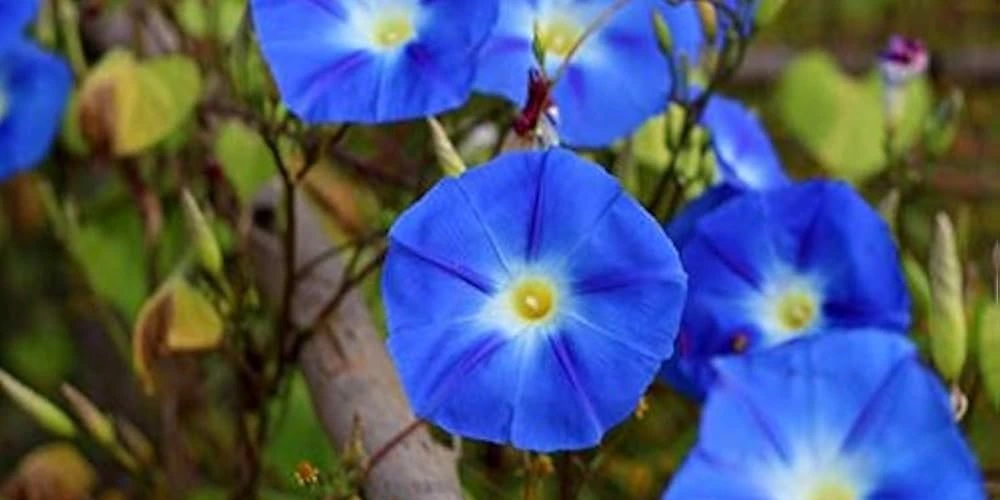 |
| Scarlet O’Hara | Bold red blooms with a white throat; adds vibrant color to any garden. | Attracts hummingbirds and makes a dramatic statement in gardens. |  |
| Moonflower | Large, fragrant white flowers that bloom at night and remain open until sunrise. | Perfect for night gardens; highly fragrant and pollinated by moths. | 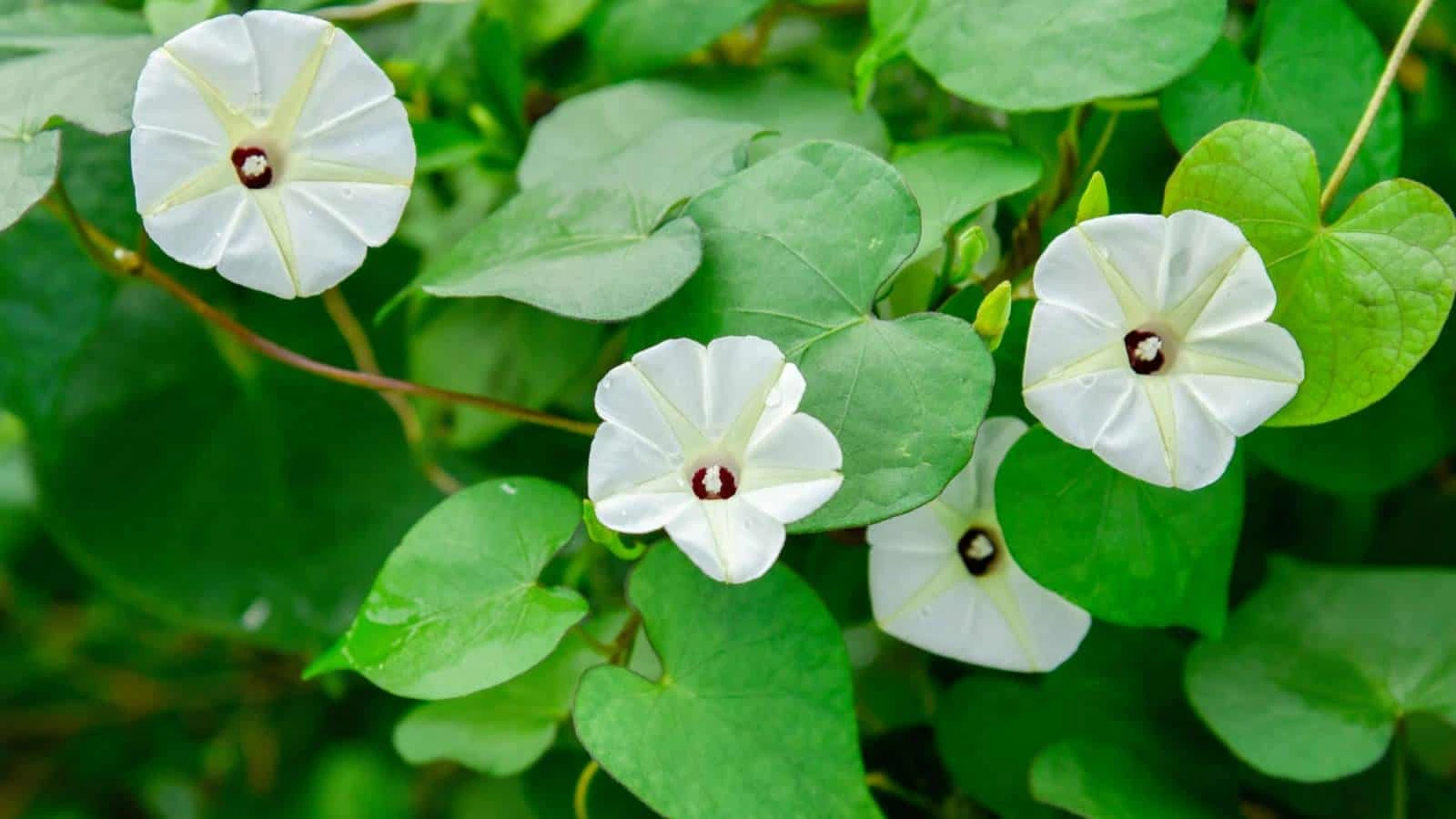 |
| Milky Way | White flowers streaked with lavender or purple; creates a delicate appearance. | Unique streaked petals make it a favorite for ornamental displays. | 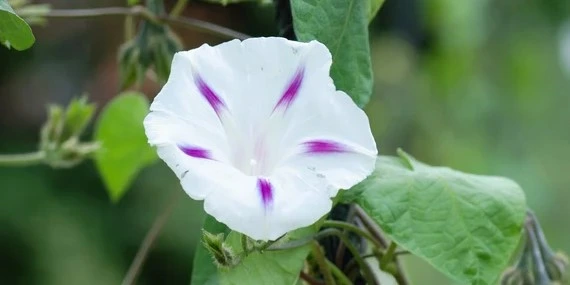 |
| Pearly Gates | Pure white blooms with a soft, luminous quality. | Adds elegance and brightness to shaded garden areas. | 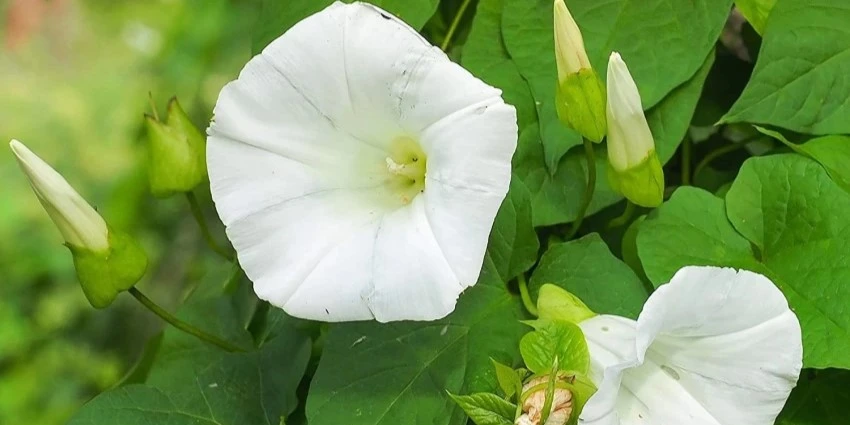 |
| Flying Saucers | Blue and white striped flowers; resembles a spinning pinwheel. | Eye-catching and whimsical design perfect for children’s gardens. |  |
| Grandpa Ott’s | Deep purple blooms with a contrasting red star pattern at the center. | Heirloom variety cherished for its rich color and vigorous growth. | 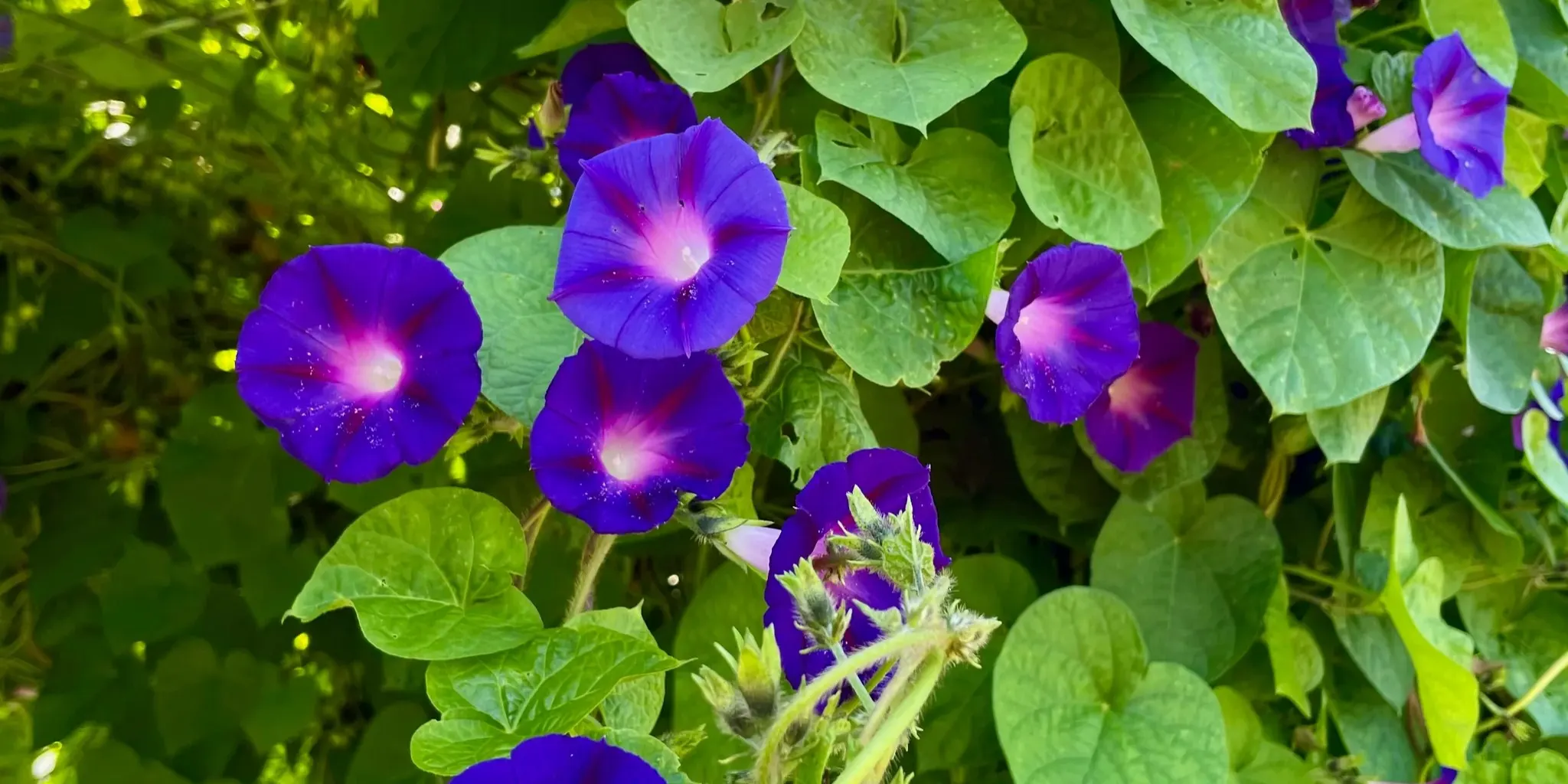 |
| Blue Star | Pale blue petals with a darker starburst pattern in the center. | Subtle and sophisticated, ideal for blending with other flowering vines. |  |
| Pink Beauty | Soft pink flowers with yellow throats; highly ornamental. | Delicate yet striking; works well in mixed flower beds or containers. | 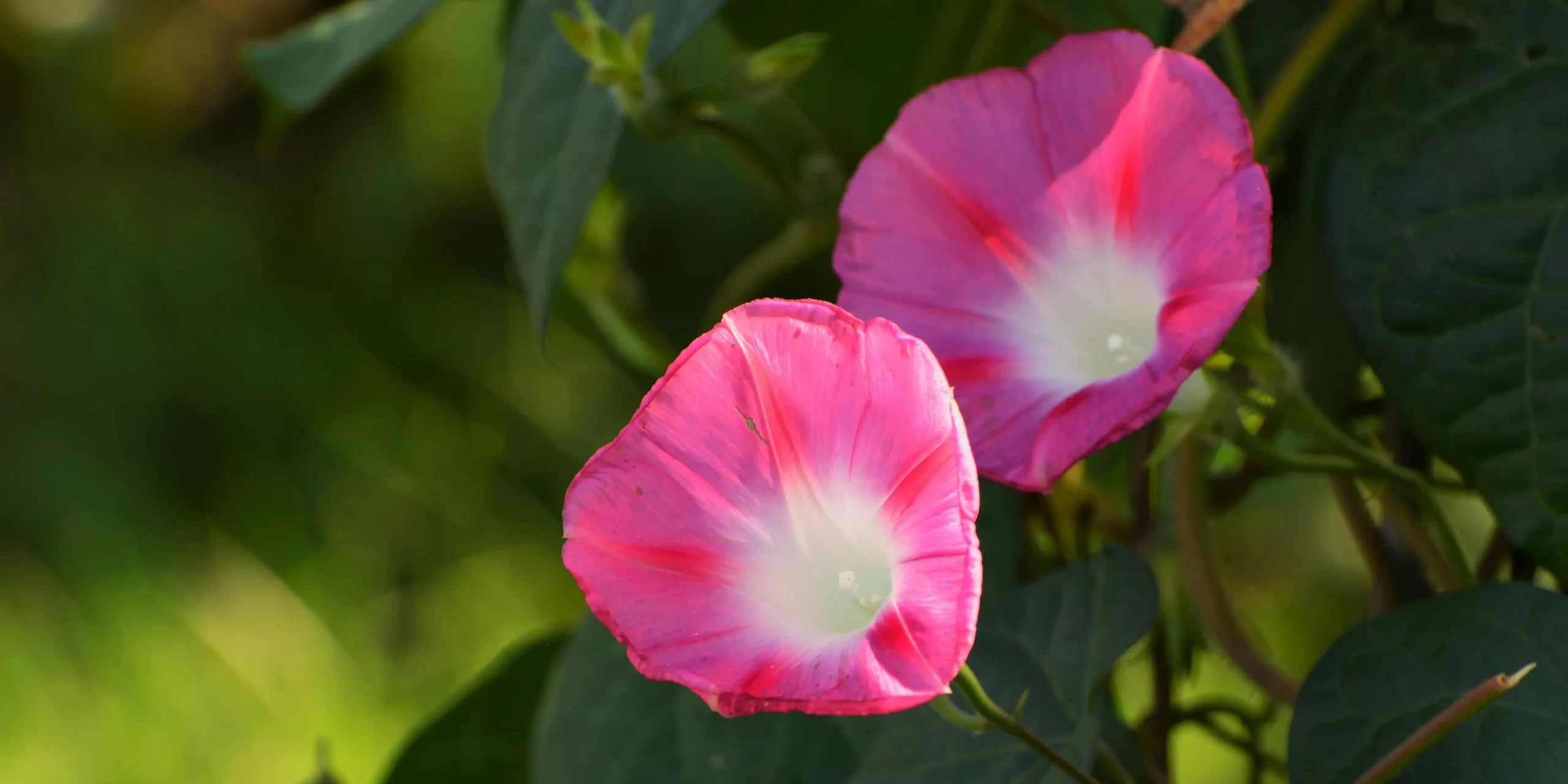 |
| Crimson Rambler | Bright crimson blooms on vigorous, fast-growing vines. | Excellent for covering large trellises or creating privacy screens. | 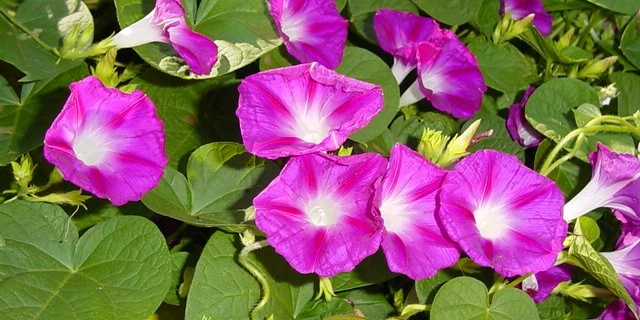 |
Choosing the Right Trellis for Morning Glory Vine
Best Materials for Trellises
The material of the trellis plays a crucial role in its durability and appearance. Here are some top choices:
- Wood: A classic and natural option, wooden trellises blend seamlessly into most garden designs. Cedar and redwood are excellent choices because they are resistant to decay and weathering.
- Metal: Durable and long-lasting, metal trellises are ideal for supporting vigorous vines like morning glories. Look for powder-coated options to prevent rust.
- Bamboo: Lightweight and eco-friendly, bamboo trellises provide a rustic look but may require replacement after a few seasons.
- PVC or Plastic: Low-maintenance and weather-resistant, these trellises are a practical choice for gardeners seeking longevity.
Size and Design Considerations
When selecting a trellis, it’s essential to consider the growth habits of morning glory vines. Here are key factors:
- Height: Morning glories can grow up to 10-15 feet tall, so the trellis should be at least 6-8 feet high to accommodate their climbing nature.
- Width: Choose a trellis wide enough to allow the vines to spread horizontally as they climb.
- Spacing of Slats: Ensure the trellis has evenly spaced slats or wires, ideally 1-2 inches apart, to allow the vines to wrap and twine easily.
- Stability: The trellis must be securely anchored to the ground or a wall to support the weight of the mature vines and withstand wind.
Suggestions for DIY and Ready-Made Options
For gardeners who enjoy crafting or want a customized look, DIY trellises are an excellent option:
- DIY Wooden Trellis: Construct a simple frame using untreated wood and attach horizontal slats or lattice. Add a coat of weather-resistant sealant to increase durability.
- Bamboo Teepee: Create a teepee structure by tying bamboo poles together at the top and spreading the bases apart in a circular shape.
- Wire and Nails: Stretch galvanized wire horizontally between two posts or a wall to create an inexpensive yet effective trellis.
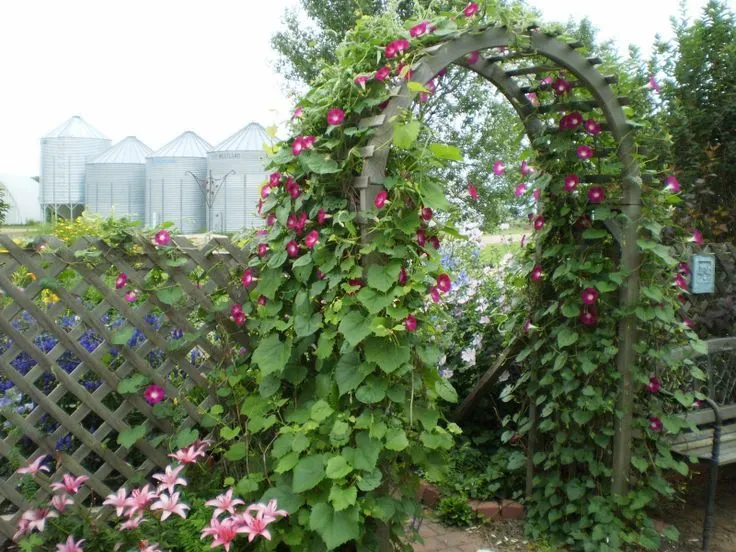

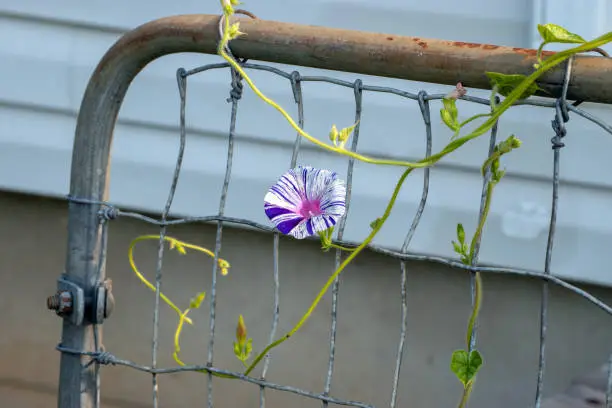
For those preferring convenience, ready-made trellises are widely available:
- Expandable Wooden Trellises: Adjustable and portable, these trellises are great for smaller spaces.
- Metal Archways: Perfect for creating a dramatic garden entrance covered in morning glory blooms.
- Wall-Mounted Grids: Ideal for small gardens or patios, these grids provide vertical support while saving ground space.
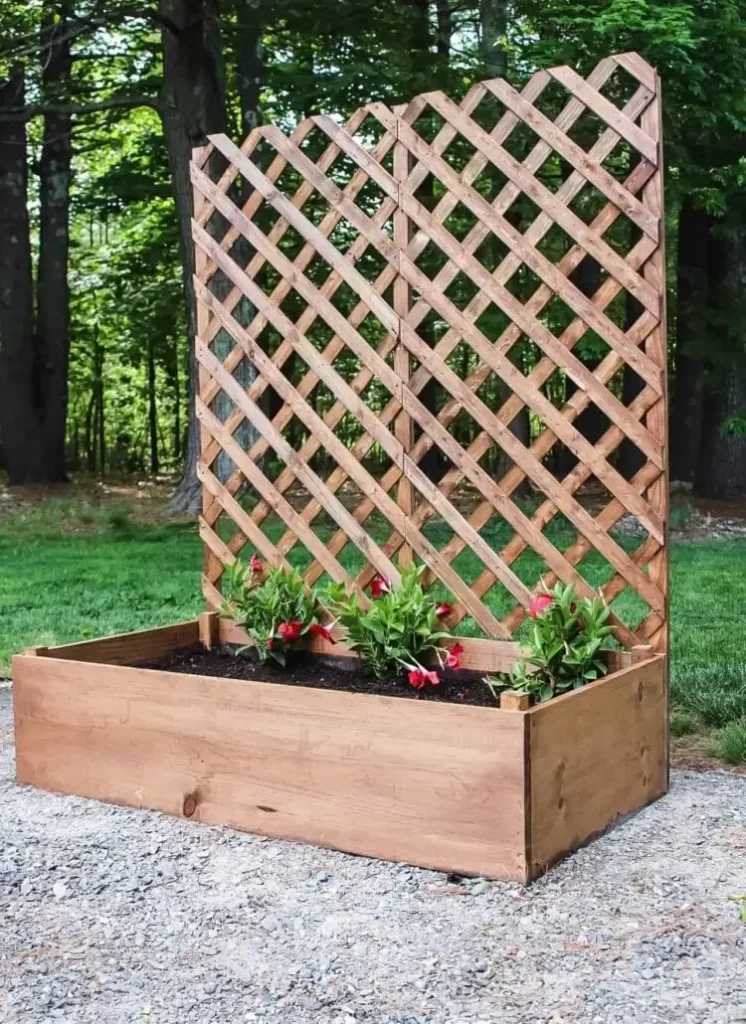
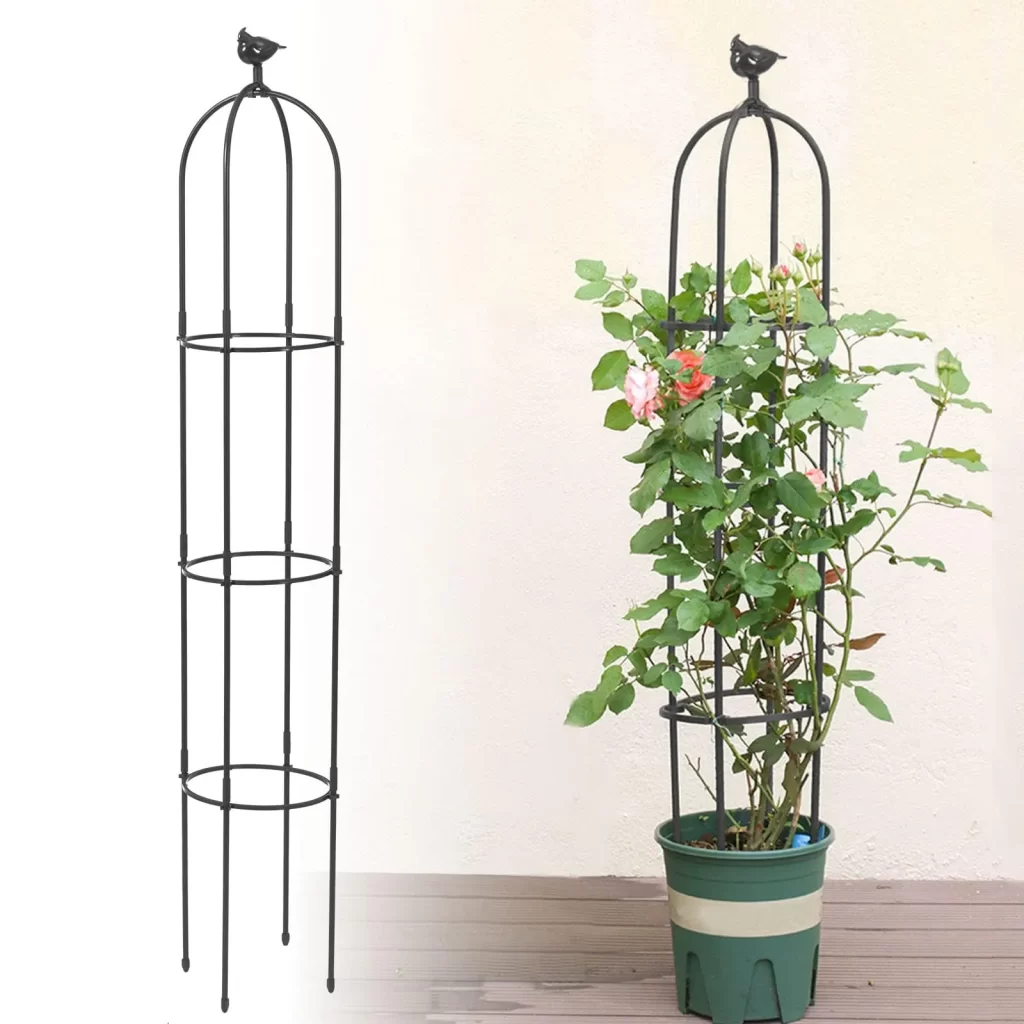

By selecting the right trellis, you’ll not only enhance the beauty of your garden but also ensure your morning glory vines thrive and bloom to their full potential.
Caring for Morning Glory Plant
Morning glories are hardy plants, but they still require proper care to thrive and produce an abundance of blooms. Here are essential tips for ensuring their health and beauty:
Watering Needs and Freeze Protection
Morning glories prefer moderate watering. Keep the soil consistently moist but avoid overwatering, which can lead to root rot. During dry spells, increase watering frequency but allow the top layer of soil to dry out slightly between waterings. Always water at the base of the plant to minimize the risk of fungal diseases.
If a freeze of 32 degrees Fahrenheit or lower is expected late in the season, you should water your seedlings in the afternoon or evening before the freeze arrives. Then, cover the seedlings with a blanket, towel, or cloche to protect them until the temperature goes above freezing.
Fertilization Tips for Morning Glory Plant
Morning glories thrive in nutrient-lean soils and generally don’t require heavy feeding. However, light fertilization can boost their flowering potential. Use a low-nitrogen fertilizer, as excessive nitrogen encourages leafy growth at the expense of blooms. Apply a balanced liquid fertilizer every 4 to 6 weeks during the growing season for optimal results.
Pruning and Maintenance of Morning Glory Plant
Regular maintenance keeps morning glories healthy and visually appealing:
- Deadheading: Remove spent flowers to promote continuous blooming and prevent the plant from focusing energy on seed production.
- Trimming Excess Growth: Prune back overgrown or tangled vines to maintain a neat appearance and improve air circulation, which reduces the risk of fungal infections.
- Weeding: Remove weeds around the base of the plant to prevent competition for nutrients and water.
Seasonal Care for Morning Glory plant
Morning glories are annuals in most regions of the U.S. but can self-seed and return the following year. Seasonal care involves ensuring that the plant thrives during its growing season and preparing for its natural lifecycle.
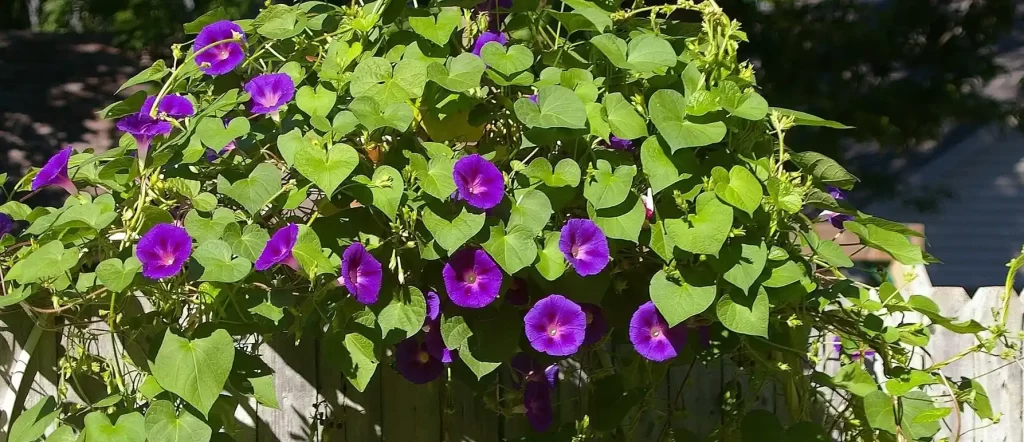
- End-of-Season Preparations:
- Allow some seed pods to mature on the vine and drop naturally to encourage self-seeding. This ensures new growth in the next season without additional effort.
- Collect mature seed pods if you wish to control the placement of future plants. Store the seeds in a cool, dry place for replanting.
- Remove dead vines and plant debris at the end of the season to reduce the risk of pests and diseases lingering in the garden.
- Winter Care:
- In warmer zones where morning glories can act as perennials, lightly prune the vines and cover the base with mulch to protect the roots from cold snaps.
- For annual varieties, simply remove the spent plants after the first frost if self-seeding is not desired.
- Spring Rejuvenation:
- Clear any remaining debris from the planting area before new growth begins.
- Lightly till the soil to aerate and mix in fresh compost for added nutrients.
- Reinstall or inspect trellises and support structures to ensure they are ready for the rapid growth of new vines.
- Support Maintenance:
- As the vines grow, periodically check that the trellis or support structure is secure and capable of holding the plant’s weight. Repair or reinforce it as needed to prevent collapse during peak growth.
- Train emerging shoots onto the trellis early in the season to establish a tidy and controlled growth pattern.
By tailoring your care to the seasons, you can enjoy a seamless and vibrant display of morning glories year after year while minimizing garden upkeep. These are annuals in most regions of the U.S. but can self-seed and return the following year. To encourage this:
- Allow some seed pods to mature and drop naturally at the end of the growing season.
- Collect seeds for replanting by harvesting mature pods and storing them in a cool, dry place.
Managing Common Pests and Diseases
While morning glories are relatively resilient, they can sometimes be affected by pests and diseases. Proper identification and management are key to maintaining healthy plants. The table below provides detailed information on common issues, symptoms, and solutions.
| Problem | Symptoms | Cause | Solution | Prevention Tips |
|---|---|---|---|---|
| Aphids | Clusters of small green, black, or yellow insects on stems and leaves; sticky residue (honeydew). | Sap-sucking insects. | Spray with insecticidal soap or neem oil. Introduce beneficial insects like ladybugs. | Regularly inspect plants; remove heavily infested leaves; encourage natural predators. |
| Spider Mites | Fine webbing on leaves; yellowing or speckled foliage. | Dry conditions; tiny arachnid pests. | Increase humidity around plants by misting; apply miticides if infestation is severe. | Maintain adequate humidity; avoid water stress. |
| Fungal Diseases (powdery mildew) | White powdery spots (powdery mildew); leaf discoloration or wilting. | Poor air circulation; excess moisture. | Remove affected parts; apply fungicides if needed. Avoid overhead watering. | Space plants properly; ensure good airflow; water at soil level. |
| Leaf Miners | Winding, discolored trails on leaves. | Larvae burrowing within leaves. | Remove and dispose of affected leaves; use insecticidal sprays if necessary. | Maintain garden cleanliness; monitor for early signs of damage. |
| Root Rot | Wilting or yellowing leaves; soggy soil; foul odor from roots. | Overwatering or poorly draining soil. | Improve drainage; avoid overwatering; remove severely affected plants. | Use well-draining soil; water sparingly and only when the topsoil is dry. |
By proactively addressing pest and disease issues, you can ensure your morning glories remain vibrant and healthy throughout the growing season.
Creative Ideas for Using Morning Glories
Morning glories are incredibly versatile in garden design. Here are some ideas to inspire you:
- Trellis Displays: Cover a trellis with a mix of morning glory varieties for a colorful, cascading effect.
- Living Privacy Screens: Train morning glory vines along fences to create a natural barrier.
- Container Gardening: Grow them in pots with a small trellis for patios and balconies.
- Mix and Match: Pair morning glories with other climbers, like clematis, for a stunning contrast.
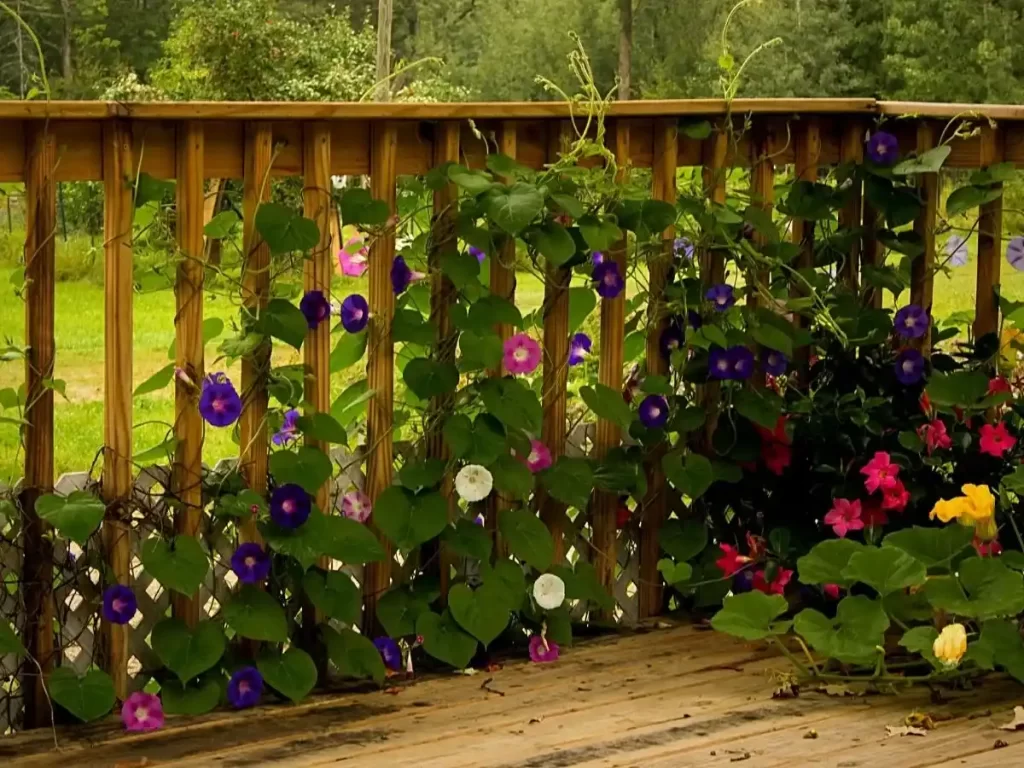


How to Harvest and Save Morning Glory Seeds for Next Season
Harvesting and saving morning glory seeds is a rewarding process that ensures you can enjoy these beautiful plants year after year without purchasing new seeds. Follow these steps to gather and store seeds effectively:
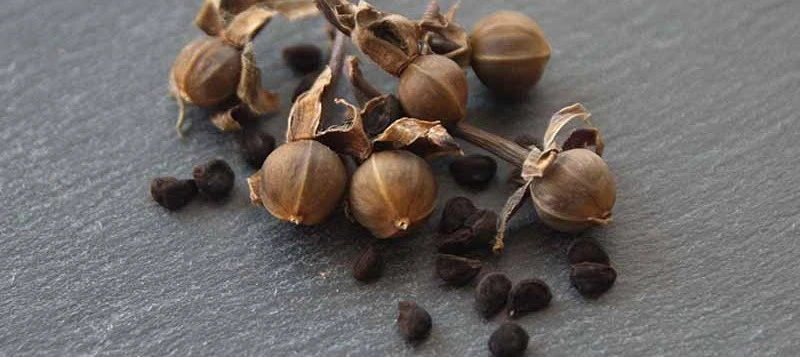
1. Identifying Mature Seed Pods
- Wait for Blooming to Finish: After the flowers fade, they form small, round seed pods where the blossoms were attached.
- Check for Maturity: Allow the pods to dry on the vine until they turn brown and become brittle. Mature pods will contain black or dark brown seeds, which are ready for harvesting.
2. Harvesting the Seeds
- Choose a Dry Day: Harvest seeds on a dry, sunny day to prevent moisture from damaging the seeds.
- Remove Pods Carefully: Use scissors or pruning shears to cut off the dry pods to avoid damaging the vine or spilling seeds.
- Open the Pods: Gently crack open the pods over a container or paper towel to collect the seeds. Discard any debris or damaged seeds.
3. Cleaning and Drying Seeds
- Inspect for Quality: Select seeds that are firm and dark in color, as these are more likely to germinate successfully.
- Air Dry: Spread the seeds on a flat surface in a cool, dry location for 1-2 days to ensure all residual moisture is removed.
4. Storing the Seeds
- Use Airtight Containers: Place the dried seeds in an airtight container, such as a glass jar or resealable plastic bag, to protect them from humidity.
- Label and Date: Clearly label the container with the seed variety and the date of harvest for future reference.
- Store in a Cool, Dark Place: Keep the container in a cool, dry location such as a refrigerator or a dark cupboard to maintain seed viability.
Morning Glory Brief Summary
| Common Name: | Morning glory, common morning glory |
| Botanical Name: | Ipomoea purpurea |
| Family: | Convolvulaceae |
| Plant Type: | Perennial, annual |
| Planting Time: | March 21st – 2nd week in April usually |
| Seed Planting Depth: | 1/2″ |
| Light: | 6 to 8 hours of direct sunlight |
| Spacing: | 6 to 12″ |
| Soil Type: | Well-draining average garden soil |
| Soil pH: | 6.0 to 7.5 |
| Height: | 6–10 ft. tall |
| Hardiness Zones: | 2–11 (USDA) |
| Toxicity: | Toxic to people, pets |
FAQs About Morning Glory Plant
Do morning glories like full sun or shade?
Morning glories thrive in full sun. They require at least 6-8 hours of direct sunlight daily to produce their best blooms. While they can tolerate partial shade, insufficient sunlight may result in fewer flowers.
Do morning glories climb a trellis?
Yes, morning glories are natural climbers and thrive on trellises, arbors, fences, or other vertical supports. Their twining stems wrap around supports, making them an excellent choice for vertical gardening.
Do morning glories come back every year?
Morning glories can be either annuals or perennials, depending on the variety and climate. In colder regions, they typically grow as annuals and need to be replanted each year. In warmer climates, perennial varieties or reseeding annuals may return yearly.
Why are morning glories illegal?
In some areas, morning glories are restricted due to their invasive nature. They can spread aggressively and outcompete native plants, particularly in regions where they thrive unchecked. Regulations aim to prevent ecological disruption. In parts of the US, species such as Calystegia sepium (hedge bindweed), Ipomoea purpurea (common morning glory) and Ipomoea indica (blue morning glory) have shown to be invasive.
Do hummingbirds like morning glories?
Yes, hummingbirds are attracted to morning glories, especially varieties with bright red, pink, or purple flowers. The trumpet-shaped blooms provide an excellent source of nectar for these pollinators.
What animal eats morning glories?
Morning glories are not banned throughout the U.S., but some varieties are restricted in certain states, such as Arizona, due to their invasive tendencies. Always check local regulations before planting.
Is Morning Glory banned in the US?
Animals like deer, rabbits, and groundhogs may nibble on morning glory plants, particularly the young shoots and leaves. Additionally, certain insects, such as caterpillars and beetles, can feed on the foliage.
That’s It
Morning glories are a gardener’s delight, offering unparalleled beauty, ease of care, and a touch of nostalgia to any landscape. From selecting the perfect variety to training their vibrant vines on trellises, these flowers provide endless possibilities for creative expression in your garden. By following the tips outlined in this guide, you’ll not only nurture thriving plants but also create a haven for pollinators and a feast for the eyes.
Whether you’re an experienced gardener or just starting out, the joy of growing morning glories lies in their simplicity and charm. As the morning sun rises and their blossoms unfurl, you’ll be reminded of nature’s remarkable artistry. So, roll up your sleeves, plant those seeds, and let the magic of morning glories transform your outdoor space. Here’s to a garden brimming with color, life, and inspiration!








